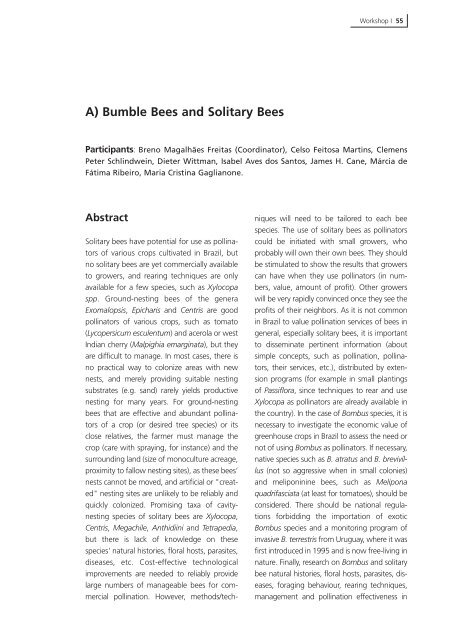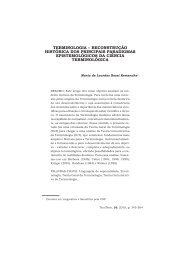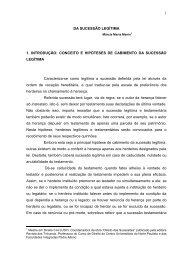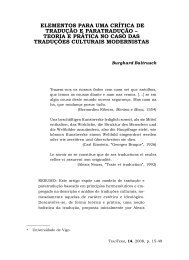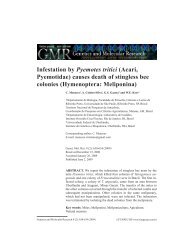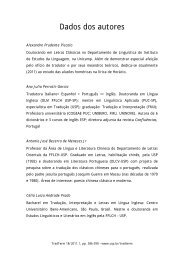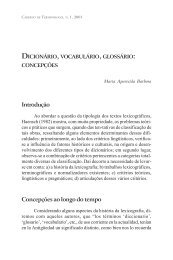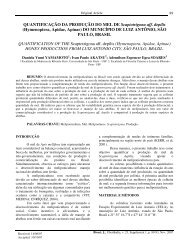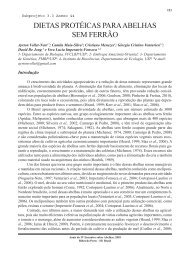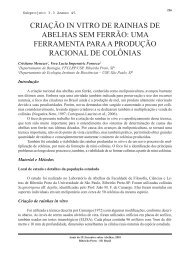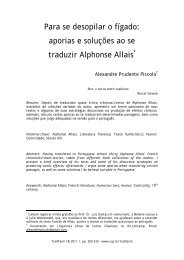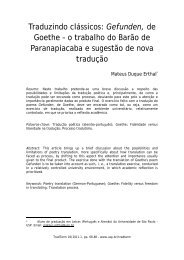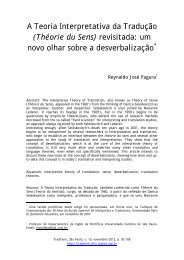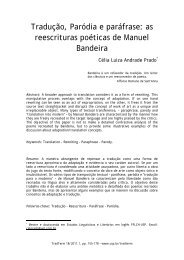Bees as pollinators in Brazil - USP
Bees as pollinators in Brazil - USP
Bees as pollinators in Brazil - USP
You also want an ePaper? Increase the reach of your titles
YUMPU automatically turns print PDFs into web optimized ePapers that Google loves.
A) Bumble <strong>Bees</strong> and Solitary <strong>Bees</strong><br />
Abstract<br />
Solitary bees have potential for use <strong>as</strong> <strong>poll<strong>in</strong>ators</strong><br />
of various crops cultivated <strong>in</strong> <strong>Brazil</strong>, but<br />
no solitary bees are yet commercially available<br />
to growers, and rear<strong>in</strong>g techniques are only<br />
available for a few species, such <strong>as</strong> Xylocopa<br />
spp. Ground-nest<strong>in</strong>g bees of the genera<br />
Exomalopsis, Epicharis and Centris are good<br />
<strong>poll<strong>in</strong>ators</strong> of various crops, such <strong>as</strong> tomato<br />
(Lycopersicum esculentum) and acerola or west<br />
Indian cherry (Malpighia emarg<strong>in</strong>ata), but they<br />
are difficult to manage. In most c<strong>as</strong>es, there is<br />
no practical way to colonize are<strong>as</strong> with new<br />
nests, and merely provid<strong>in</strong>g suitable nest<strong>in</strong>g<br />
substrates (e.g. sand) rarely yields productive<br />
nest<strong>in</strong>g for many years. For ground-nest<strong>in</strong>g<br />
bees that are effective and abundant <strong>poll<strong>in</strong>ators</strong><br />
of a crop (or desired tree species) or its<br />
close relatives, the farmer must manage the<br />
crop (care with spray<strong>in</strong>g, for <strong>in</strong>stance) and the<br />
surround<strong>in</strong>g land (size of monoculture acreage,<br />
proximity to fallow nest<strong>in</strong>g sites), <strong>as</strong> these bees’<br />
nests cannot be moved, and artificial or "created"<br />
nest<strong>in</strong>g sites are unlikely to be reliably and<br />
quickly colonized. Promis<strong>in</strong>g taxa of cavitynest<strong>in</strong>g<br />
species of solitary bees are Xylocopa,<br />
Centris, Megachile, Anthidi<strong>in</strong>i and Tetrapedia,<br />
but there is lack of knowledge on these<br />
species' natural histories, floral hosts, par<strong>as</strong>ites,<br />
dise<strong>as</strong>es, etc. Cost-effective technological<br />
improvements are needed to reliably provide<br />
large numbers of manageable bees for commercial<br />
poll<strong>in</strong>ation. However, methods/tech-<br />
Workshop I 55<br />
Participants: Breno Magalhães Freit<strong>as</strong> (Coord<strong>in</strong>ator), Celso Feitosa Mart<strong>in</strong>s, Clemens<br />
Peter Schl<strong>in</strong>dwe<strong>in</strong>, Dieter Wittman, Isabel Aves dos Santos, James H. Cane, Márcia de<br />
Fátima Ribeiro, Maria Crist<strong>in</strong>a Gaglianone.<br />
niques will need to be tailored to each bee<br />
species. The use of solitary bees <strong>as</strong> <strong>poll<strong>in</strong>ators</strong><br />
could be <strong>in</strong>itiated with small growers, who<br />
probably will own their own bees. They should<br />
be stimulated to show the results that growers<br />
can have when they use <strong>poll<strong>in</strong>ators</strong> (<strong>in</strong> numbers,<br />
value, amount of profit). Other growers<br />
will be very rapidly conv<strong>in</strong>ced once they see the<br />
profits of their neighbors. As it is not common<br />
<strong>in</strong> <strong>Brazil</strong> to value poll<strong>in</strong>ation services of bees <strong>in</strong><br />
general, especially solitary bees, it is important<br />
to dissem<strong>in</strong>ate pert<strong>in</strong>ent <strong>in</strong>formation (about<br />
simple concepts, such <strong>as</strong> poll<strong>in</strong>ation, <strong>poll<strong>in</strong>ators</strong>,<br />
their services, etc.), distributed by extension<br />
programs (for example <strong>in</strong> small plant<strong>in</strong>gs<br />
of P<strong>as</strong>siflora, s<strong>in</strong>ce techniques to rear and use<br />
Xylocopa <strong>as</strong> <strong>poll<strong>in</strong>ators</strong> are already available <strong>in</strong><br />
the country). In the c<strong>as</strong>e of Bombus species, it is<br />
necessary to <strong>in</strong>vestigate the economic value of<br />
greenhouse crops <strong>in</strong> <strong>Brazil</strong> to <strong>as</strong>sess the need or<br />
not of us<strong>in</strong>g Bombus <strong>as</strong> <strong>poll<strong>in</strong>ators</strong>. If necessary,<br />
native species such <strong>as</strong> B. atratus and B. brevivillus<br />
(not so aggressive when <strong>in</strong> small colonies)<br />
and melipon<strong>in</strong><strong>in</strong>e bees, such <strong>as</strong> Melipona<br />
quadrif<strong>as</strong>ciata (at le<strong>as</strong>t for tomatoes), should be<br />
considered. There should be national regulations<br />
forbidd<strong>in</strong>g the importation of exotic<br />
Bombus species and a monitor<strong>in</strong>g program of<br />
<strong>in</strong>v<strong>as</strong>ive B. terrestris from Uruguay, where it w<strong>as</strong><br />
first <strong>in</strong>troduced <strong>in</strong> 1995 and is now free-liv<strong>in</strong>g <strong>in</strong><br />
nature. F<strong>in</strong>ally, research on Bombus and solitary<br />
bee natural histories, floral hosts, par<strong>as</strong>ites, dise<strong>as</strong>es,<br />
forag<strong>in</strong>g behaviour, rear<strong>in</strong>g techniques,<br />
management and poll<strong>in</strong>ation effectiveness <strong>in</strong>


